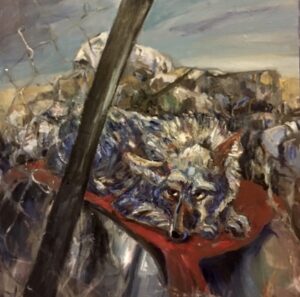 Maybe the only way to depict Coyote is with disappearing ink. As soon as the i’s are dotted and the t’s crossed on some summarizing fact or observation, this scrappy resilient American cousin to the wolf and dog has already reformed into a new way of being, and moved to a new place. Everything coyote is in flux. Up for grabs. Twisted round and round in some Mobius strip of human history and culture, and the private realms of dreams, fears, and desire.
Maybe the only way to depict Coyote is with disappearing ink. As soon as the i’s are dotted and the t’s crossed on some summarizing fact or observation, this scrappy resilient American cousin to the wolf and dog has already reformed into a new way of being, and moved to a new place. Everything coyote is in flux. Up for grabs. Twisted round and round in some Mobius strip of human history and culture, and the private realms of dreams, fears, and desire.
I first encountered Coyote when I was a teenager camping in the Southwest with an intrepid group of girls. We saw ourselves as wild strong young women, and yet when the coyotes sang from the red rocks or the sage brush or halfway up some sacred mountain, we wondered how wild we really were. It felt like the coyotes were following our caravan, watching us set up our tents and gather wood, and waiting just out of sight for us to light the campfire. We sang a lullaby to appease them: Desert Silvery Blue Beneath the Pale Moonlight/Coyotes yippin lazy on the hill…
I would wait fifty years before I actually got a good look at living coyotes. Not in the West. By now coyotes have migrated to every state in the union. I was attending a workshop in Vermont and had slept alone under the stars. In the morning I left my sleeping bag and walked down the road, into a field dusted with snow. I met two coyotes. They were bigger than German shepherds, and their legs long and graceful, their perfect ears pricked slightly forward, their eyes shining with white gold light of the rising sun. I’m not sure why I turned away first. It was my choice. Not coyotes’.
Later that day, my husband called to say our good brown dog had died early that morning. But Ben died in September. Can there be frost that early? Maybe this is not how things were. Maybe it’s how they became. How they keep on becoming in some way–like Ben– unbound by time and space.
Here and not here. This is coyote to me. The animal has been evolving on this continent for a million years and migrating through our individual and collective imaginations at least since humans stepped foot on this continent. First Peoples recognized him as a trickster demigod who scattered the stars, created the animals, invented death, the ultimate fool and a stand-in for humans. 15,000 years later, European Americans saw merely a filthy, destructive, despicable creature no better than a rat that must be exterminated. Today, like so much these days, the coyote remains a polarizing entity. You can probably predict a person’s political persuasion by asking them how they feel about coyotes—or even how they pronounce the word. Coyote couldn’t care less. He just keeps going along, his aggravating, confounding, incredibly adaptive resilient self. There seems to be no end to what coyote can do. No beginning either.


